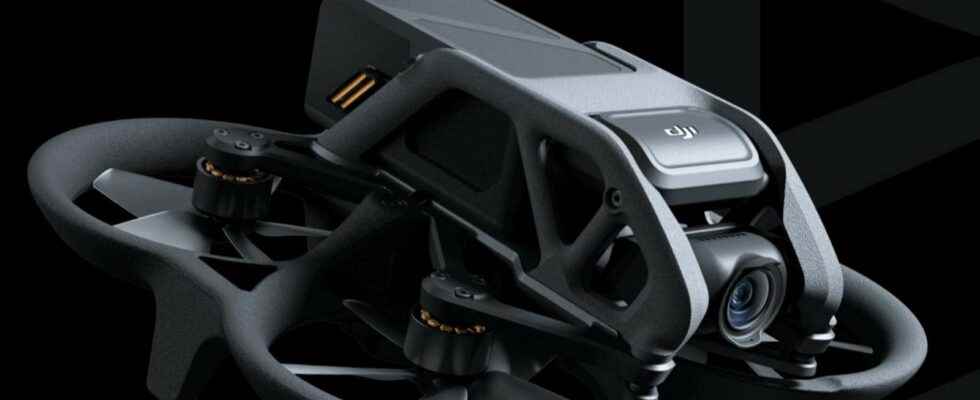You will also be interested
In March 2021, DJI made a strong impression by unveiling its DJI-FPVa drone that Futura had tested and which had impressed us. With his helmet, he made it possible to learn about the immersion piloting that racers like, that is to say drone pilots evolving very quickly on circuits. Thanks to its assistance, the drone could be taken in hand by a beginner and an expert could disengage it to find the piloting specific to drone racers.
Today, the Chinese brand returns to this segment with theAvatar. The principle is identical, with a drone and an FPV headset. But this time, the drone leaves its racy look for more sobriety in favor of a reduced size that allows it to sneak around. It is endowed with fairings of propellers to avoid breakage and injuries during evolutions. Note that these each have five blades, unlike the DJI FPV which included three.
The body of theaircraft mainly consists of the battery. This plugs into a rudimentary structure, no doubt to lighten it and better withstand shocks. Under the aircraft are two sensors to estimate the distance from the ground. Unlike the DJI FPV, there are no proximity sensors on the front. Caution therefore, during the evolutions, especially if one ventures into Sport mode or that one disengages in manual mode with its very particular piloting.
At the front, we find the suspended camera with its 1.17-inch 48-megapixel sensor. It represents the equivalent of a 35 mm with a viewing angle of 155°. It can be tilted and has digital stabilization. With it, the Avata sees itself as a “cinewhoop” drone, i.e. a drone racer equipped with a camera powerful enough to produce high quality film sequences.
A new FPV headset
At the level of the helmet, there is change. The helmet is lighter, it loses two of its four antennae, which gives the impression of wearing small horns. They can be folded up, to avoid dismantling them when you want to have space to store the helmet. Both screens improve and have a definition of 1,920 x 1,080 with high brightness and a latency of 30 milliseconds according to DJI. To adjust these screens to his view, two knobs are available under the helmet. For those who suffer from sight problems, the manufacturer delivers two supports for lentils corrections to add to the screens.
With 4K/60fps video, a 155 degree field of view and an improved stabilization algorithm, DJI Avata is the “ultimate flight” experience drone. © DJI
On the settings side, rather than the tiny joystick and its buttons located on the helmet, we now use a touch surface for orders. This is done from the right side of the helmet. As for the radio control, you can connect the same model as that of the DJI FPV. The Joystick motion controller is also available.
Armed with its battery, the Avata drone weighs just over 400 grams. Inside you can do whatever you want, but outside, side regulations in theory at European level, it is positioned in a limited sub-category and needs to be accompanied by an observer. At the beginning of 2024, it will be classified in sub-category A3 and its range of use will be much more restrictive. For the moment, in France, no need to register it on the AlphaTango portal and add a sticker with the registration number.
For prices, the drone is available in different versions from 579 euros without helmet or radio control. It is found in Bundle mode from 1,149 euros with the same helmet as the DJI FPV and the controller of movements. It goes to 1,429 euros if you opt for the new helmet called DJI Goggles 2. The additional batteries are sold for 119 euros each.
Interested in what you just read?
